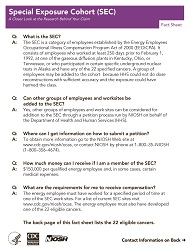Special Exposure Cohort (SEC)
December 2005
DHHS (NIOSH) Publication Number 2005-143

This fact sheet address six common questions concerning the special exposure cohort (SEC). Q: What is the SEC? A: The SEC is a category of employees established by the Energy Employees Occupational Illness Compensation Program Act of 2000 (EEOICPA). It consists of employees who worked at least 250 days prior to February 1, 1992, at one of the gaseous diffusion plants in Kentucky, Ohio, or Tennessee, or who participated in certain specific underground nuclear tests in Alaska and have any of the 22 specified cancers. A group of employees may be added to the cohort because HHS could not do dose reconstructions with sufficient accuracy and the exposure could have harmed the class. Q: Can other groups of employees and worksites be added to the SEC? A: Yes, other groups of employees and work sites can be considered for addition to the SEC through a petition process run by NIOSH on behalf of the Department of Health and Human Services (HHS). Q: Where can I get information on how to submit a petition? A: To obtain more information go to the NIOSH Web site at https://www.cdc.gov/niosh/ocas, or contact NIOSH by phone at 1-800-35-NIOSH (1-800-356-4674). Q: How much money can I receive if I am a member of the SEC? A: $150,000 per qualified energy employee and, in some cases, certain medical expenses. Q: What are the requirements for me to receive compensation? A: The energy employee must have worked for a specified period of time at one of the SEC work sites. For a list of current SEC sites visit https://www.cdc.gov/niosh/ocas/. The energy employee must also have developed one of the 22 eligible cancers. Q: What are the 22 eligible cancers? A: 1. Bone Cancer. 2. Renal Cancers 3. Lung cancer (other than in-situ lung cancer that is discovered during or after a post-mortem exam). If the onset of the disease was at least 2 years after first exposure: 4. Leukemia (other than chronic lymphocytic leukemia). If the onset of the disease was at least 5 years after first exposure: 5. Multiple myeloma. 6. Lymphomas (other than Hodgkin’s disease). 7. Primary cancer of the Bile ducts. 8. Brain. 9. Breast (female). 10. Breast (male). 11. Colon. 12. Esophagus. 13. Gall bladder. 14. Liver (except if cirrhosis or hepatitis B is indicated). 15. Ovary. 16. Pancreas. 17. Pharynx. 18. Salivary gland. 19. Small intestine. 20. Stomach. 21. Thyroid. 22. Urinary bladder.
